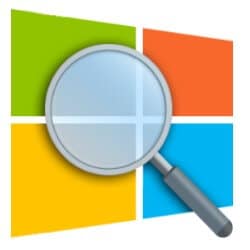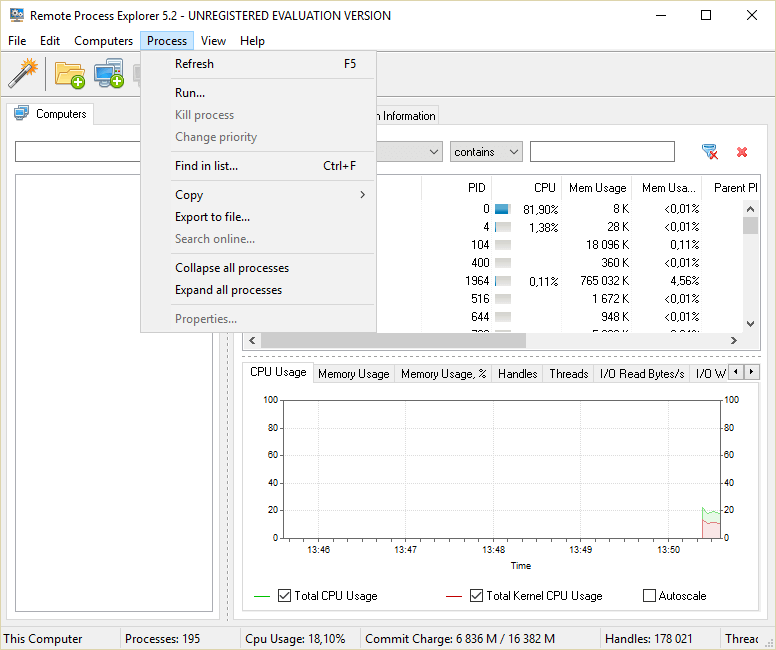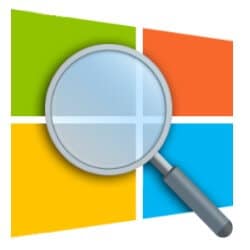Remote Process Explorer Activation bypass + Keygen Full Version Free Download

Remote Process Explorer 22.10 Activation bypass is a small tool for all external administrators who need to manage clients instantly across one or more domains. With RPE, administrators can see all processes running on a client and, of course, terminate them. RPE also displays services, their status and startup type, and allows you to directly access the c$ share or open a remote command shell (winrs) to connect to clients via RDP. But that is not all. RPE displays errors and warnings from the last 30 days in the application event log and system event log.
LizardSystems’ Remote Process Explorer allows you to manage processes on local or remote computers in real time. LizardSystems’ Remote Process Explorer allows you to get a list of processes and manage them. On local or remote computers, users can terminate processes, start new processes, and change process priorities.
To do this, the program uses the built-in functionality of the operating system, so no additional software needs to be installed on the remote computer. Remote Process Explorer allows you to view complete information about any running process. It also shows when the process was started, who the user was who started the process, the path to the executable, and the amount of memory and CPU used by the process.
Manage remote processes and control remote computers. Remote Process Explorer is free for personal use and replaces Windows Task Manager with an advanced version. Remote Process Explorer allows you to monitor all your local and remote processes from a single interface and access important process information such as process ID, parent PID, priority, handles, threads, etc. Real time.
The product displays complete information about all local and remote processes, including ownership information, CPU time and memory consumption, and the path to executable files. For added security, if you are unsure whether a particular process is malware, you can use Remote Process Explorer to search the Internet for processes, obtain additional information, and generate reports on known malware. You can start, stop, or change the priority of processes running on local or remote PCs. Remote Process Explorer displays processes as a process tree so you can easily navigate between processes and their dependencies.
If you want, you can easily end all processes with a specific name. Get everything done with Windows Task Manager on your local and remote PCs. Network administrators will appreciate the fact that they do not need to install Remote Process Explorer on every system on the network. Runs on a single server and provides secure control of remote PCs. Remote computer management includes remote shutdown and restart with sufficient privileges.
Remote Process Explorer Activation bypass retrieves and updates the list of available network computers completely automatically. To speed up operations, the product maintains a list of remote PCs in a local cache. By combining a cached list of computers connected to your network with an actual list, Remote Process Explorer can display all computers on your network, regardless of whether they are turned on or off.
The interface has a very confusing layout, a lot of information is stored in different tabs and tables. Of course, this doesn’t just apply to first-time users, as the entire tool can be very confusing.
In summary, Remote Process Explorer is a very effective software for controlling processes and services remotely. Although this interface is only intended for advanced users and the response times are not necessarily the best, it does not affect system performance and we did not encounter any errors, crashes or crashes during our testing.
Features & Highlights:
- Shows all processes running on the remote client
- End the process on the remote client
- Displays services on remote clients, service status, and service startup type.
- Start and stop services on remote clients
- View, copy, and paste system and application event log entries (last 30 days)
- Open a connection directly to the client via RDP
- Open a remote command shell on a remote client
- Show C$ Remote Client in Explorer
- Displays additional information such as free C space, availability, and operating system version.
- Get the group a remote client user is currently connected to (AD)
- Can be used with parameters to automate scripts.
- Displays the (normal) software installed on the remote host
- Now works faster with background tasks.
- Use menus to view native Windows.msc services and the Eventviewer console
- Monitor all processes running on local and remote computers.
- Displays the parameters of a running process, e.g. B. Process ID, parent PID, CPU, memory usage, priority, handles, threads, etc.
- View all parameters in real time.
- See the process tree.
- End selected processes at any time.
- Change the priority of a process on a remote computer.
- Run a new process on a remote computer.
- Search the Internet for information about the selected process.
- Add Computer Wizard.
- Group in the computer list.
- Displays the computer status (on/off) in a list.
- Automatically updates the computer list.
- Two ways to find out the status of your computer.
- Use different accounts for each computer.
- Shut down and restart the remote computer.
- Additional management tools
- Command line: Run commands on a remote computer.
- File System: Browse remote file systems.
- Logs: Access event logs to view errors and warnings.
- Storage: Monitor remote storage usage.
- Modules: Displays the modules loaded for each process.
- Network: Checks remote network connections.
- Performance: Monitor the performance of remote systems.
- Process Information: Displays detailed information about the process.
- Processes: Monitor and explore remote processes.
- Registry: Access and modify remote registries.
- Security: Check security measures remotely.
- Services: View and manage remote services.
- Tasks: View scheduled tasks and jobs.
- Threads: Displays the threads of each process.
- Windows: Go to Windows System Properties.

What’s New?
- Added: Clear process tree.
- Added: Send message to all sessions.
- Add: Send a message to the session.
- Added: Shadow session for the selected process.
- Added: Connecting to a remote desktop on a connected server.
- Add: Closes the session of the selected process.
- Added: Tool to send messages to the management tool.
- A remote shutdown tool has been added to the admin tools.
- Changed: Remote Process Explorer versioning has been changed to use calendar versioning.
- Updated: Ability to change user credentials for the remote shutdown tool.
- Update: Set the process hierarchy view when starting the program.
- Update: Added a login password for the shutdown command.
- Updated: Process filters. Store the default filter selections in different columns.
- Fixed: Programs not displaying correctly on the indoor screen after removing the outdoor screen.
- Fixed: Process owner detection.
- Solution: I/O error 131 occurs when starting a program.
- Fix: A small bug has been fixed.
Remote Process Explorer Keygen:
- FqEKmxokLi-M0fASDaGrkjTsdy-ZED4zYQP4g
- JWy3TdAUT2-w77SDXRzj1lj-vOml9DQSSWeq
- QIQTNCgiT-ZQfFoDFFWaVE-RkfOwDbrmGnxf
- XTfqjWAxHzzK-UFGwkG1pLKb-XM3kVklffrT
- 5i0N8sfUgLgeh-a8IhDF9SpH32Ow-dG6qYxg
You may Also Like:
System Requirements:
- System: Windows 7 / Vista / 7/8/10
- RAM: Minimum 512 MB.
- HHD space: 100 MB or more.
- Processor:2 MHz or faster.
How to Install Remote Process Explorer Activation bypass?
- Download the software and run the installation file.
- Click “I Agree” to continue.
- Select the installation method and click “Next”.
- Change the installation folder and click “Next”.
- Select the components and click Install to start the installation.
- After setup is complete, click Close.
- Done! Enjoy it.
Download Link
#Remote #Process #Explorer #Activation bypass #Keygen #Free #Download



